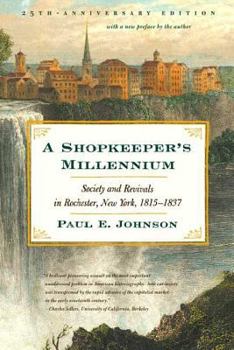A Shopkeeper's Millennium: Society and Revivals in Rochester, New York, 1815-1837
Select Format
Select Condition 
Book Overview
A quarter-century after its first publication, A Shopkeeper's Millennium remains a landmark work--brilliant both as a new interpretation of the intimate connections among politics, economy, and... This description may be from another edition of this product.
Format:Paperback
Language:English
ISBN:0809016354
ISBN13:9780809016358
Release Date:June 2004
Publisher:Hill & Wang
Length:240 Pages
Weight:1.20 lbs.
Dimensions:0.7" x 5.6" x 8.3"
Customer Reviews
5 ratings
textbook
Published by Thriftbooks.com User , 15 years ago
This is one of the textbooks my daughter needed for her college class. It is one she will keep.
Great Book
Published by Thriftbooks.com User , 23 years ago
For those who want to discover how the Second Great Awakening affected the town of Rochester, New York, then this book is for you. You can tell the amount of hardwork that Johnson put into this book by the sheer amount of information that is contained within.
Excellent study of "The Burnt-Over District" of upstate NY.
Published by Thriftbooks.com User , 24 years ago
New York State's construction of the Erie Canal transformed the tiny frontier town of Rochester into young America's first inland boom town, with an economy based on milling local grain and transporting the flour east to feed the older coastal cities. In this role, it became the prototype for all the thousands of commercial towns and cities that sprang up along railroads across the Midwest during the nineteenth century, as well as the crucible in which the Midwest's particular brand of evangelical protestant piety was first worked out. 'A Shopkeeper's Millenium' is by far the best examination of this important piece of American history I have found anywhere, and I recommend it highly.
Highly readable social history.
Published by Thriftbooks.com User , 24 years ago
Paul Johnson's highly readable case study of Finney-inspired revivals in Rochester argues that these revivals were a response to the breakdown of social relationships involving work. His research finds that the revivals converted the relatively stable entrepreneurial class of Rochester who had recently abandoned former traditional employer-employee relationships where the employee boarded within the home of the employer. The revival legitimized this abandonment (and the resulting free labor system) by emphasizing the individual's moral freedom. Furthermore, the revival united the entrepreneurial class behind a mission-oriented Protestantism that enabled them to assert economic pressure, and a measure of social control, over the working class. While clearly sympathetic to the working class perspective, Johnson does not create a Protestant hegemonic conspiracy where none existed. Although one may dissent from his fundamental assumptions and approach, Johnson's argument is quite effective within the framework he has set for himself. I recommend this work to students of religion and society and antebellum reform.
Revivals, Charismatic Actors of the Second Great Awakening.
Published by Thriftbooks.com User , 25 years ago
Through patient research (six years in the making) and profound interpretation Paul E. Johnson has composed a small, but masterful, account of how the rising bourgeois class of Rochester, New York shaped its budding culture around religious action within the tsunami of pre-industrialism that was flooding American mill and manufacturing towns during the early nineteenth century. Taking Rochester as a representative microcosm of the new capitalist paradigm that was sweeping the new nation, A Shopkeeper's Millennium dissects the roots, causes, changes, and outcomes that occurred during 1815 to 1837 that paved the way to a new dominant culture where old paternalistic norms for social control gave in to devout religious internalization. Johnson's thesis centers around the climatic role that the Rochester religious revival of 1831 played in converting not only individuals first, but in the aftermath, Rochesterian society as a whole. The Rochester revival of 1831 played a! ! vital role in the Second Great Awakening. Rochester was the pivotal point in Charles Gradison Finney's rise to fame. As Peter Worsley in his book, The Trumpet Shall Sound, discovered that "charisma provides `more than an abstract ideological rationale...It is a legitimation grounded in a relationship of loyalty and identification in which the leader is followed simply because he embodies values in which the followers have an interest.'" Through Finney's charisma, converted Rochesterians; many being the master workmen or manufacturers; took the proverbial "bull by the horns" and ran with their new found paradigm--a paradigm that justified, through religious conversion, the acts that one social class should dominate another for economic gain. Prior to the 1831 revival, social construction in Rochester was quite different.





